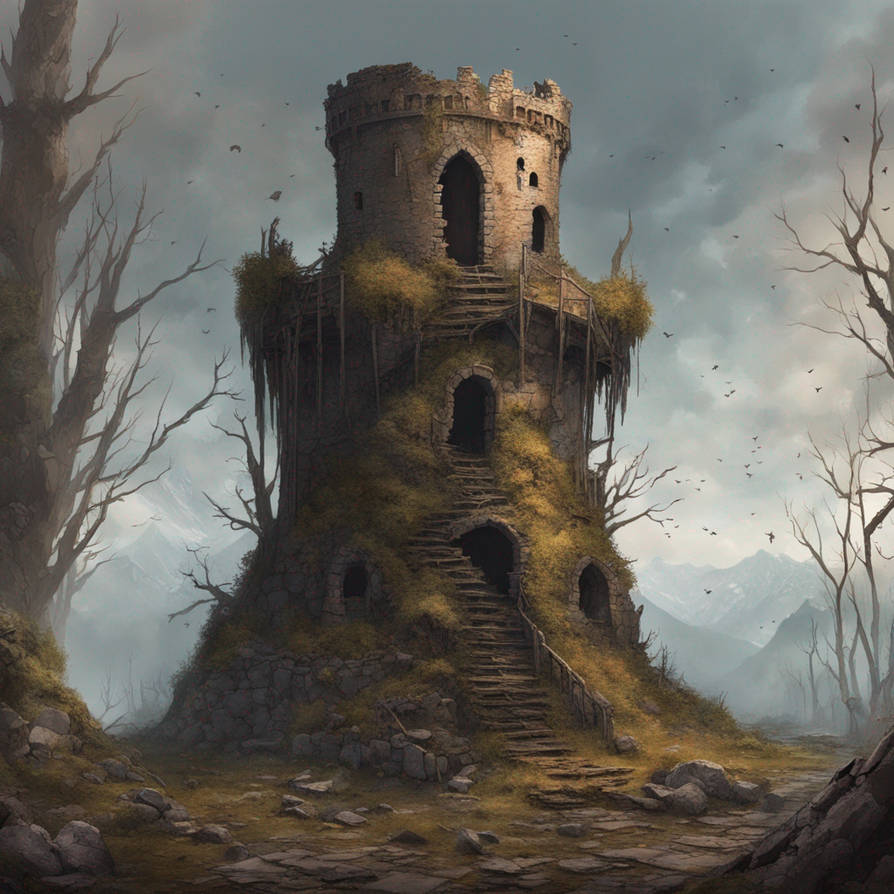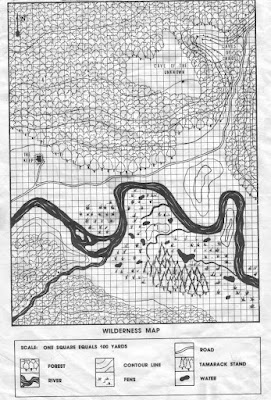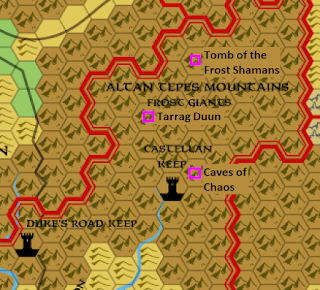The Temple of Chaos Divided is a megadungeon in Alphatia, created by the mad archmage Volsoon who revelled in the idea of Chaos and its worship. Volsoon was a nobleman and archmage in Shiell in northern Alphatia about 250 years ago who set up his tower and associated temple complex about 20 miles north of the city by the village of Lymewood. He attracted likeminded followers, including apprentice mages, chaotic clerics, fighters and thieves. He also became one of the most powerful Twisted Summoners of northern Alphatia. And in classic twisted summoner style he used kobold minions along with his own spells and the spells of his apprentices to gradually create a dungeon underneath.
Generally he was quite low-profile in his chaos worship. But in AC 760 he unleashed hordes of monsters and chaos worshippers on the city of Shiell and Lymewood. The village residents fled to Shiell, and the attack on the city was repelled with powerful magic and Volsoon was quickly found to be behind the attack. The city authorities, supported by a number of civic-minded archmages, laid siege to Volsoon’s tower and temple. The surface structures were raided and left as burnt ruins and his magnificent wizard’s tower was toppled. But the dungeons underneath were a different prospect, mainly because of how extensive they were. So the village of Lymewood became the hub of efforts to contain the malevolent chaos of Volsoon’s dungeon, with Markalvion the Lawful mage establishing Lymewood Outpost, a school and residence for mages who oppose chaos. Lymewood also has a recently-expanded church of Law, the Lymewood Bastion, previously just a chapel, now manned by a high-level cleric and his acolytes and junior clerics.
 |
| Only the bottom third of Volsoon's tower now stands. source |
Temple Factions
Volsoon was fascinated by different aspects of Chaos and he created different temples deep under his tower:
- The Temple of Chaos Destructive (the Destroyers) are often brutish, seeking more power to crush their enemies and anyone else they come across. Moreso than other factions there is a belief among this group that might makes right or at least that might is much more important than right.
- The Temple of Chaos Indulgent (the Indulgers) focus on the selfishness of Chaos and often follow their whims and feelings, always looking after themselves. They are usually greedy for both food and treasure and enjoy various decadent pleasures. Life is short and pointless, so you might as well have some fun while you are here.
- The Temple of Chaos Terrifying (the Terrors) see the world as being full of dangers. They both feel this fear themselves and also inflict the fear on those around them. They tend towards domination and control, using fear to keep underlings in line and can be quite hierarchical and tyrannical.
- The Temple of Chaos Unpredictable (the Erratics) focus on the randomness of chaos and may emulate this in their behaviour. They can appear to be quite mad, talking gibberish and behaving bizarrely, and are great believers in luck and randomness.
- The Temple of Chaos Entropic (the Entropists) understands that the Multiverse is heading towards entropy and that life is temporary and death is permanent. They embrace undeath, viewing it as the next stage after life.
- The Temple of Chaos Malevolent (the Hateful) are the most unpleasant of a bad bunch, looking to inflict pain on those around them.
- The Temple of Chaos Grandiose (the Ambitious) seek to enhance their own power and are among the most duplicitous. They can be very well organised if they think it is in their own interests, but will stab each other in the back at the drop of a hat.
These different factions within the dungeon do not usually get on with each other, and there are often struggles between these temples for supremacy, resources, ideology and good old fashioned vendettas. This could result in PC adventurers finding unlikely allies, particularly if members of a faction are in a tight spot and could do with any help they can get. That does not mean they are reliable or trustworthy allies - they are still thoroughly chaotic.
The factions usually consist of a core of chaotic humans, mostly Alphatian in ethnicity with many being clerics and mages, and then their monstrous allies and auxilliaries who may not be interested in the faction's philosophy but will serve for food, money and their own need for allies. Volsoon himself, various apprentices and many of the human mages currently in the dungeon are Twisted Summoners and so a wide variety of monsters may be encountered, from the ubiquitous kobolds to much larger creatures including giants and dragons. The third and fourth levels are known to have much larger chambers and corridors (typically 20ft high x 20ft wide) to accomodate such creatures.
Physical Layout
There is one main entrance to the dungeons from the surface - the spiral staircase in the centre of Volsoon’s tower that used to lead upwards as well as down until the tower was toppled. However, there are rumours of magical portals within the dungeon that connect to corresponding portals elsewhere. While Volsoon was alive and active he would sometimes be seen in his tower and then less than twenty minutes later in the middle of Shiell. This could just be a teleport spell but those who knew him reckon there was at least one magic portal between the dungeon and the city. Then there is the village well in Lymewood which drops down about 100ft to the water surface. But those who have descended the well shaft say that the water is actually an underground lake in a huge cavern with tunnels leading off in the distance towards the dungeon.
There are numerous levels, at least 10 have been described by captured cultists and more levels and sublevels are suspected. Each level has a similar pattern - a central hub, usually containing the stairs going up and down, and then sections radiating off from the central hub. These sections happen to be geomorphs, generally 190ft x 190ft with entrances and exits in the middle of each side. The baffling thing about this dungeon is that although the central hubs keep the same structure every time one enters, the geomorphic sections can sometimes change between visits. Nobody beyond Volsoon himself and maybe his most senior apprentices knows how this happens, but it must involve powerful magic. Nobody from the surface has witnessed this change so it is not clear whether the sections warp and morph into their new shapes or if entire sections of dungeon are somehow transported around and swapped with each other.
As with many dungeons there may be some static and irreplaceable encounters, while others are more fluid. Both recruits from outside and twisted summoners summoning new monsters can replenish areas that were cleared out by adventuring parties, or else creatures move in from other parts of the dungeon. Animated undead and even some of the simpler constructs may be replaced by the chaotic spellcasters from deep in the dungeon. The timescale this takes will vary (weeks? months?) but generally speaking rooms will not be repopulated within a single expedition. Unique NPCs generally stay dead unless the most powerful cult clerics deem them worth the effort of a Raise Dead spell.
The Surface Ruins
0.1) The Tower Base. Although the upper storeys have collapsed (see 0.10), the first two storeys of Volsoon's tower are still relatively intact (though clearly in need of repair). The door to the tower is kept locked by the authorities at Limewood village but can be opened on request. There is a spiral staircase in the middle of the tower that leads down to the first level of the dungeon and up to the first floor. The ground floor is empty though there are some very old ashes and burnt remnants of furniture. Upstairs the ceiling has mostly rotted away leaving the first storey open to the sky. A giant robber fly (7hp) has made its home here on the upper floor and will attack if disturbed. It has no treasure.
0.2) The Surface Temple. This edifice of Chaos has been gutted by fire, with the remnants of burnt pews, lecturns and banners in between the pillars. There is a black basalt altar at the north end. Careful observation will show there are dried blood stains on it. The altar will give off a Chaotic aura if any cleric uses a Detect Chaos spell but has no specific magical effects.
0.3) The Cloister now holds 3 stirges (hp 5, 6, 2) that will attack anyone entering. There is the skeletal corpse of an adventuring cleric slumped in one corner. He still wears serviceable chain mail armour and has a mace, a holy symbol of a lawful saint, and 12sp & 15gp in his belt pouch.
0.4) The Outhouse: This was used for ablutions and as a toilet. Now it is empty.
0.5) First Stable: Empty
0.6) Second Stable: 1 giant crab spider (hp 7) crawls around the rafters.
0.7) Servants Quarters. Empty
0.8) Servants Quarters. Empty apart from smashed and rotten furniture.
0.9) Servants Quarters. Among rotten furniture 3 giant rats (hp 2 each) live here. They are likely to flee to the rubble field (0.10) through a hole in the back wall.
0.10) Rubble field. This is what remains of the upper storeys of the wizard's tower when it toppled. Grass and weeds have grown up around the large chunks of masonry. A pack of 6 giant rats (hp 2 each) have made their home here, and they have found crevices that only small creatures (giant rats, gnomes and halflings) can get into. If they fail their morale they will retreat back into these small lairs. In one of these crevices there is the rats' treasure: 1200sp and 4 pieces of clear quartz worth 30gp each.









